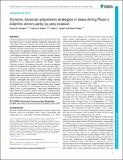Files in this item
Dynamic biosonar adjustment strategies in deep-diving Risso's dolphins driven partly by prey evasion
Item metadata
| dc.contributor.author | Jensen, Frants H. | |
| dc.contributor.author | Keller, Onno A. | |
| dc.contributor.author | Tyack, Peter L. | |
| dc.contributor.author | Visser, Fleur | |
| dc.date.accessioned | 2021-02-03T00:37:00Z | |
| dc.date.available | 2021-02-03T00:37:00Z | |
| dc.date.issued | 2020-02 | |
| dc.identifier | 266452055 | |
| dc.identifier | a9e4d350-2d1a-4d81-aa3b-fb5eddb3e468 | |
| dc.identifier | 85079018357 | |
| dc.identifier | 31822550 | |
| dc.identifier | 000541784000017 | |
| dc.identifier.citation | Jensen , F H , Keller , O A , Tyack , P L & Visser , F 2020 , ' Dynamic biosonar adjustment strategies in deep-diving Risso's dolphins driven partly by prey evasion ' , Journal of Experimental Biology , vol. 223 , jeb216283 . https://doi.org/10.1242/jeb.216283 | en |
| dc.identifier.issn | 0022-0949 | |
| dc.identifier.other | ORCID: /0000-0002-8409-4790/work/69463369 | |
| dc.identifier.uri | https://hdl.handle.net/10023/21359 | |
| dc.description | Funding: ONR (grants N00014-15-1-2553 and N00014-18-1-2062) and acknowledges the support of the MASTS pooling initiative (The Marine Alliance for Science and Technology for Scotland) in the completion of this study. MASTS is funded by the Scottish Funding Council (grant reference HR09011) and contributing institutions. | en |
| dc.description.abstract | Toothed whales have evolved flexible biosonar systems to find, track and capture prey in diverse habitats. Delphinids, phocoenids and iniids adjust inter-click intervals and source levels gradually while approaching prey. In contrast, deep-diving beaked and sperm whales maintain relatively constant inter-click intervals and apparent output levels during the approach followed by a rapid transition into the foraging buzz, presumably to maintain a long-range acoustic scene in a multi-target environment. However, it remains unknown whether this rapid biosonar adjustment strategy is shared by delphinids foraging in deep waters. To test this, we investigated biosonar adjustments of a deep-diving delphinid, the Risso's dolphin (Grampus griseus). We analyzed inter-click interval and apparent output level adjustments recorded from sound recording tags to quantify in situ sensory adjustment during prey capture attempts. Risso's dolphins did not follow typical (20logR) biosonar adjustment patterns seen in shallow-water species, but instead maintained stable repetition rates and output levels up to the foraging buzz. Our results suggest that maintaining a long-range acoustic scene to exploit complex, multi-target prey layers is a common strategy amongst deep-diving toothed whales. Risso's dolphins transitioned rapidly into the foraging buzz just like beaked whales during most foraging attempts, but employed a more gradual biosonar adjustment in a subset (19%) of prey approaches. These were characterized by higher speeds and minimum specific acceleration, indicating higher prey capture efforts associated with evasive prey. Thus, tracking and capturing evasive prey using biosonar may require a more gradual switch between multi-target echolocation and single-target tracking. | |
| dc.format.extent | 9 | |
| dc.format.extent | 821136 | |
| dc.language.iso | eng | |
| dc.relation.ispartof | Journal of Experimental Biology | en |
| dc.subject | Echolacation | en |
| dc.subject | Sensory ecology | en |
| dc.subject | Mesopelagic foraging | en |
| dc.subject | Deep-water environment | en |
| dc.subject | Biosonar strategies | en |
| dc.subject | Gain control | en |
| dc.subject | GC Oceanography | en |
| dc.subject | QH301 Biology | en |
| dc.subject | Aquatic Science | en |
| dc.subject | Animal Science and Zoology | en |
| dc.subject | Ecology, Evolution, Behavior and Systematics | en |
| dc.subject | Insect Science | en |
| dc.subject | Molecular Biology | en |
| dc.subject | Physiology | en |
| dc.subject | DAS | en |
| dc.subject.lcc | GC | en |
| dc.subject.lcc | QH301 | en |
| dc.title | Dynamic biosonar adjustment strategies in deep-diving Risso's dolphins driven partly by prey evasion | en |
| dc.type | Journal article | en |
| dc.contributor.institution | University of St Andrews. School of Biology | en |
| dc.contributor.institution | University of St Andrews. Centre for Social Learning & Cognitive Evolution | en |
| dc.contributor.institution | University of St Andrews. Scottish Oceans Institute | en |
| dc.contributor.institution | University of St Andrews. Sea Mammal Research Unit | en |
| dc.contributor.institution | University of St Andrews. Sound Tags Group | en |
| dc.contributor.institution | University of St Andrews. Bioacoustics group | en |
| dc.contributor.institution | University of St Andrews. Marine Alliance for Science & Technology Scotland | en |
| dc.identifier.doi | 10.1242/jeb.216283 | |
| dc.description.status | Peer reviewed | en |
| dc.identifier.url | https://jeb.biologists.org/content/223/3/jeb216283.supplemental | en |
This item appears in the following Collection(s)
Items in the St Andrews Research Repository are protected by copyright, with all rights reserved, unless otherwise indicated.

